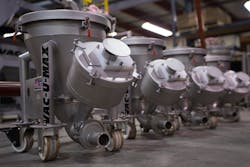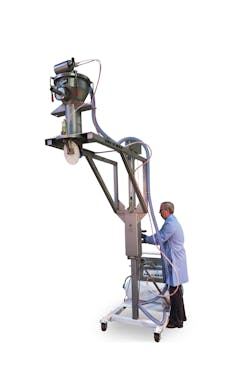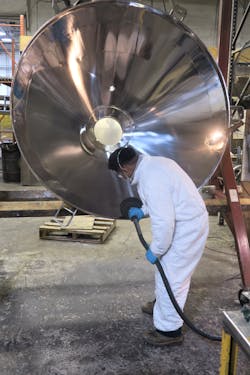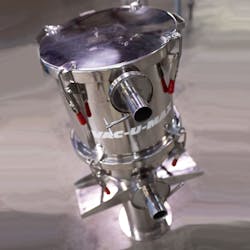Vacuum conveyors: Powder handling’s antidote to soaring post-pandemic costs
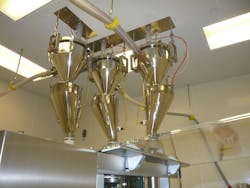
Manufacturers and processors have survived economic downturns and market shifts since the beginning of the industrial revolution. Even in good times, cost control and efficiency have always been, and will always be, reigning topics in manufacturing.
The COVID-19 pandemic — much like the Great Depression and World War II — tested manufacturing processes in the extreme, highlighted shortcomings in current practices and challenged manufacturers and processors to rethink standard operating procedures to maximize efficiency.
“We’ve never experienced inflation, recession, pandemic, supply chain issues, social inflation, and labor shortage — all converging at the same time,” notes Matthew Moore, executive vice president and president of underwriting for Liberty Mutual Global Risk Solutions.1 In the “landscape of turbulence” described by Moore, automating processing and packaging lines with vacuum conveyors is logical because it cuts costs in many ways.
Mechanical conveyors, such as aero-mechanical and flexible screw conveyors, are cheaper on the front end but may be more expensive when considering the total cost of ownership. Mechanical conveyors have more moving parts than vacuum conveyors and require regular downtime for maintenance and replacement parts. Mechanical conveyors also require more floor space than vacuum conveyors. Floor space is already a focus point for plant managers, and that will most likely intensify as manufacturers reimagine just-in-time (JIT) supply chain approaches.
Vacuum conveyors are the most hygienic method for transferring powders and bulk solids. The systems are fully enclosed, which protects materials from air, dirt and waste. Because material does not escape from a vacuum conveying system, particulates that can endanger worker health, jam expensive equipment or result in cross contamination do not escape into the environment.
Automating powder transfer with a vacuum conveying system — whether it is a complex PLC-controlled, computer-compatible, multi-ingredient storage batching and processing system, or a simple "up-and-in" material transfer system — reduces labor costs, reduces injury and its associated costs, increases throughput, fortifies quality, and allows manufacturers to rethink how they purchase raw materials.
Conveyor components and design
Versatile, small-footprint vacuum conveying systems easily integrate with existing processes by routing conveying lines between floors, through partitions or around machinery, and they can be easily rerouted to accommodate process modifications.
Vacuum conveyors are fairly simple systems comprising four basic components — a pickup point, a power/vacuum source, a vacuum receiver (also called a filter receiver) and a control panel — which work together to gently transfer powders and bulk solids through convey tubing. Each component must complement the others. If one component is too large or too small, it will keep the system from working properly. Vacuum receivers must be able to handle the airflow provided by the vacuum source, and the correct air-to-cloth ratio for the filters is crucial to prevent the filters from shredding or blinding.
As simple as vacuum conveying systems are, design variations are nearly endless. This is because each manufacturing process is unique and requires a system engineered to that specific process. Factors such as material bulk density, material characteristics, conveying distance, conveying rate, industry and upstream/downstream equipment all influence a system’s design, making vacuum conveying more art than science.
While industry may dictate a system’s materials of construction (such as stainless steel for food and pharmaceutical applications), vacuum conveying technology and techniques are not consigned to a particular industry but are adaptable across industries.
Expertise in vacuum technology, knowledge of production equipment and processes, and a full understanding of material characteristics, are essential to designing a system that truly benefits the bottom line.
Reduced labor costs
Without question, reduced labor is where companies achieve significant savings when going from manual material loading to automated vacuum conveyors. Surprisingly, however, reducing labor costs is not usually the main impetus for purchasing a vacuum conveyor. Two of the most common reasons companies automate powder transfer are when changes in demand make manual transfer unfeasible and when they need to mitigate safety hazards.
Most often, manually transferring materials into process or packaging equipment requires two workers for safety and efficiency, as most equipment is located above workers’ heads, requiring lifting and climbing. Vacuum conveyors facilitate loading from ground level up into process and packaging equipment, eliminating the need for workers to climb up and down ladders to manually dump materials into equipment.
Most facilities experience an immediate 50% reduction in labor for material transfer when transitioning from manual handling to vacuum conveying. This increases manufacturers’ ability to expedite the shift to a skilled workforce.
Some systems perform more like a set-it-and-walk-away scenario. Systems such as this allow businesses to achieve significant labor savings, since workers no longer need to remain at a station for the duration of the process.
Improved safety and cleanliness
The enclosed nature of vacuum conveying systems reduces the amount of housekeeping needed to mitigate fugitive dust that is inherent with manual loading of powders and bulk solids. Any time powders or bulk dry materials are open dumped into a process, whether it is a blender, a hopper, or a packaging machine, a puff of dust is generated, launching particulates into the air and creating fugitive dust.
In environments where combustible dusts are present or materials have the potential to cause respiratory injury to workers, vacuum conveying mitigates fugitive dust hazards and reduces housekeeping requirements.
According to the CDC, “Musculoskeletal disorders are associated with high costs to employers such as absenteeism, lost productivity, and increased health care, disability, and worker’s compensation costs.”2
Avoiding manual scooping, lifting and dumping of materials not only eliminates costly work-related musculoskeletal disorders (WMDS) but also eliminates the possibility of dust entering workers’ airways during manual dumping of powders. More often than not, the need to wear respiratory protection during powder transfer is not necessary with vacuum conveying systems.
Reduced downtime and maintenance
“Next to a safety or environmental mishap, unplanned/unscheduled downtime represents one of the costliest events at any industrial or manufacturing plant,” according to the Forbes article, “Unplanned Downtime Costs More Than You Think.”3 Mechanical conveyors contain more moving parts than vacuum conveyors, and therefore maintenance costs are higher, and machinery is more susceptible to unscheduled downtime.
More moving parts also means that mechanical conveyors are more difficult to clean than vacuum conveyors, making mechanical conveyors less desirable in sanitary conditions. With virtually no moving parts, vacuum conveying systems are more economical when it comes to cleaning and preventative maintenance, needing minimal attention a couple times a year to check oil levels and motor health. Compressed air-powered venturi systems require even less maintenance — simply keeping the compressed air line clean and dry.
Furthermore, the ability to change out a vacuum conveying system’s hoses and filters between batches results in faster changeovers and increased uptime. In sanitary environments where cleaning takes place several times per day, this time-saving technique can save thousands of dollars each day.
Other benefits
Additional savings when changing from manual powder transfer to automated vacuum conveyors come from reduced materials costs — either through discounted pricing for bulk quantities, reclamation and reuse of materials, or both. With material costs skyrocketing, facilities are increasingly looking for systems that can reclaim expensive materials and automatically cycle them back into the system. Ancillary equipment and innovative system engineering can even turn the task of straightforward dust collection into fully integrated systems designed to reclaim expensive ingredients and preserve quality formulations.
Vacuum conveyors further contribute to higher quality formulations since weighing and metering with an automated system eliminates the possibility of human error during hand scooping.
Vacuum conveying systems are available with a range of power options that fit within an organization’s energy management program and are capable of operating within sustainable industrial solar-powered environments.
Selecting a vacuum conveying system
Properly designed vacuum conveyors have a high ROI. These systems maximize throughput, have minimal maintenance requirements, reduce safety costs, cut changeover downtime, and improve product quality. When selecting a vacuum conveyor for your application, work with an experienced supplier with fabrication abilities and the know-how to anticipate challenges ahead of time to ensure that the system operates flawlessly for decades.
Be sure to examine the equipment’s robustness, ease of cleaning, energy consumption and warranties, because cheaper upfront does not always mean cheaper in the long run. Saving several thousand dollars on the front end may end up costing tens of thousands of dollars over the life of the system. Be sure to compare apples to apples and not apples to oranges.
References
1. https://business.libertymutual.com/insights/economic-uncertainty-and-risk-management-resilience-in-2023-3-trends-to-watch/
2. https://www.cdc.gov/workplacehealthpromotion/health-strategies/musculoskeletal-disorders/evaluation-measures/index.html
3. https://www.forbes.com/sites/forbestechcouncil/2022/02/22/unplanned-downtime-costs-more-than-you-think/?sh=44521d3036f7
Doan Pendleton is president of Vac-U-Max, Belleville, NJ (800-822-8629; [email protected]). The company manufactures pneumatic systems and support equipment for the conveying, weighing and batching of dry materials.
Vac-U-Max
